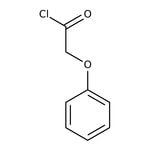Search Thermo Fisher Scientific
Phenoxyacetyl chloride, 98%, Thermo Scientific Chemicals



Phenoxyacetyl chloride, 98%, Thermo Scientific Chemicals
Chemical Identifiers
Specifications
Description
This Thermo Scientific Chemicals brand product was originally part of the Alfa Aesar product portfolio. Some documentation and label information may refer to the legacy brand. The original Alfa Aesar product / item code or SKU reference has not changed as a part of the brand transition to Thermo Scientific Chemicals.
Acylation of D- and DL-WV with phenoxyacetyl chloride, followed by cleavage of the t-butyl ester,afforded the penultimate penicilloic acids. Phenoxyacetyl chloride was used in the synthesis of series of macrocyclic bis-β-lactams, 5-phenyl-6-epiphenoxymethylpenicillin benzyl ester, N-protected guanosine derivatives, useful in RNA synthesis, phenyloxyketene, for cycloaddition to imines leading to β-lactams. Treatment of iminophosphoranes with phenoxyacetyl chloride afforded respectively the trans- and cis-3-(acylamino)-p-lactams. By the oxidative addition of stannous fluoride to allyliodide, with 1, 2-O-isopropylidene-D-glyceraldehyde and phenoxyacetyl chloride results in the predominant formation of erythro homoallylester, which is in turn converted into 2-deoxy-D-ribose. The 4-disubstituted P-lactams (4a-c and 6a-b) were prepared through the reaction of N,N-diphenylhydrazones and N-methyl-N-phenylhydrazones of ketones with phenoxyacetyl chloride/Et3N in dichloromethane.
Notes
Moisture Sensitive. Store in cool place. Keep container tightly closed in a dry and well-ventilated place. Store away from strong oxidizing agents, moisture.
Figures
Documents & Downloads
Certificates
Frequently asked questions (FAQs)
Citations & References
Safety and Handling
Classification of the substance or mixture
CLP classification - Regulation(EC) No 1272/2008
Label Elements
Signal Word
Danger
Hazard Statements
H314 - Causes severe skin burns and eye damage
H335 - May cause respiratory irritation
EU Specific Hazard Statements
EUH014 - Reacts violently with water
Precautionary Statements
P280 - Wear protective gloves/protective clothing/eye protection/face protection
P301 + P330 + P331 - IF SWALLOWED: Rinse mouth. Do NOT induce vomiting
P303 + P361 + P353 - IF ON SKIN (or hair): Take off immediately all contaminated clothing. Rinse skin with water or shower
P304 + P340 - IF INHALED: Remove person to fresh air and keep comfortable for breathing
P305 + P351 + P338 - IF IN EYES: Rinse cautiously with water for several minutes. Remove contact lenses, if present and easy to do. Continue rinsing
P310 - Immediately call a POISON CENTER or doctor/physician